 |
| September 29, 2020 | Volume 16 Issue 37 |
Designfax weekly eMagazine
Archives
Partners
Manufacturing Center
Product Spotlight
Modern Applications News
Metalworking Ideas For
Today's Job Shops
Tooling and Production
Strategies for large
metalworking plants
Jet fighters and BMWs: Trends in manufacturing
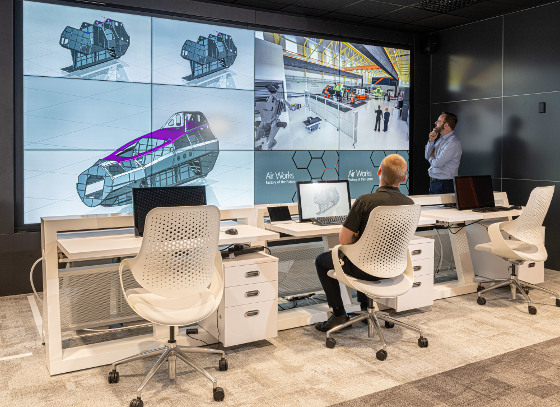
BAE Systems' new intelligent smart factory in Warton is set to increase productivity and revolutionize combat aircraft production in the UK.
At a new facility in Warton, Lancashire, BAE Systems is applying game-changing digital technologies to advance manufacturing of the UK's next-gen combat jet fighter called Tempest. Their updated toolbox includes a digitally connected intelligent factory, digital twins, automated robots and cobotic technologies, and intelligent workstations. Carmaker BMW in Germany is updating its factories and process tech too, focusing on using augmented reality in prototyping and building a new 3D-printing tech center in Munich.
Tempest is somewhat of an enigma. It is a UK-led international (European) future combat air system due to be in service by 2035. Right now, exactly what will end up in the sixth-generation stealth aircraft is a work in progress. It is seen as the long-off replacement for the supersonic (Mach 1.5) Typhoon multi-role jet fighter, which particularly shines in air-to-air combat because it is so agile. Typhoon is made of just over 80% carbon- and glass-fiber reinforced composites.
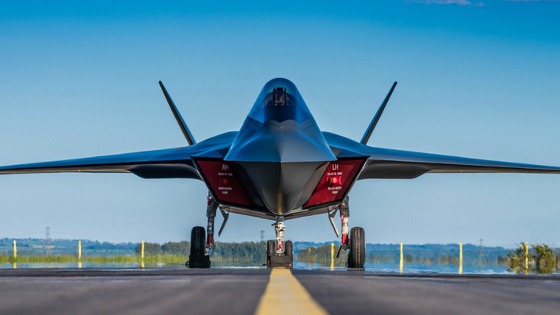
The next-gen Tempest fighter concept was first unveiled at the Farnborough International Airshow in 2018.
BAE Systems likes to talk about the Tempest as whole system, rather than a "platform" or "aircraft." The project "forms part of a wider UK-led effort to define the requirements for a future air combat system and ultimately deliver the most advanced engineering project Britain has ever seen." The concept, complete with delta-wing twin-engine model, was officially unveiled at the Farnborough International Airshow in 2018.
BAE's Factory of the Future is the result of a multimillion-dollar investment and collaboration with more than 40 blue chip and SME companies, along with academic institutions. Forefront partners from the UK (Leonardo UK, Rolls Royce, and MBDA UK), Italy (Leonardo Italy, Elettronica, Avio Aero, and MBDA Italia), and Sweden (Saab and GKN Aerospace Sweden) will explore more than 60 technology areas in total, experimenting with different ideas ranging from the physical shape of an aircraft to the sophisticated sensors that will become the brains of a future system.
The digital twin concept underpins the entire engineering lifecycle for Tempest. From initial designs to manufacture and support, the concept aims to create an open and agile workspace for those involved in the program. Data from intelligent robots, supply chain databases, and machines is digitally threaded together to deliver increased efficiency and accuracy in the manufacturing process.
"The technologies now available to us mean that we can reduce the design cycle, which in itself is good for the affordability of a program, but we can also perform more cycles very quickly until we get it right," said Michael Christie, director, Future Combat Air Systems, BAE Systems.
Conceptual shapes for the aircraft have been virtually designed and tested, with high-performance computers able to calculate the aerodynamic performance of different aircraft features and test pilots taking Tempest to the skies from a ground-based simulator. Once digitally tested, scale models were 3D-printed and put through their paces at BAE Systems' wind tunnel facilities at Warton to physically test the aerodynamic properties of the design under wind speeds of more than twice the speed of sound. Data from these trials is now being used to refine and shape the final design of the UK's next combat aircraft, with an aim to put it into service by 2035.
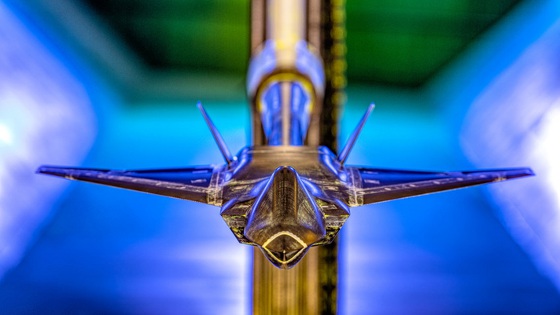
A 3D-printed scale model of the Tempest is tested in the wind tunnel at BAE Systems in Warton.
Key technology areas under development include: augmented human performance (a virtual cockpit shown on a pilot's helmet-mounted display), artificial intelligence and autonomy, cyber technologies and intelligence, surveillance, target acquisition and reconnaissance, space and hypersonic technologies, and analytics and computing. As technologies are developed and green-lighted, they also may be added to the Typhoon in coming years.
BAE builds a lot of military tech, so its Factory of the Future is not short of work. Cobotic and flexible robotic technologies remove the need for heavy, fixed, long-lead tooling and can quickly switch from the manufacture of one item or platform to another.
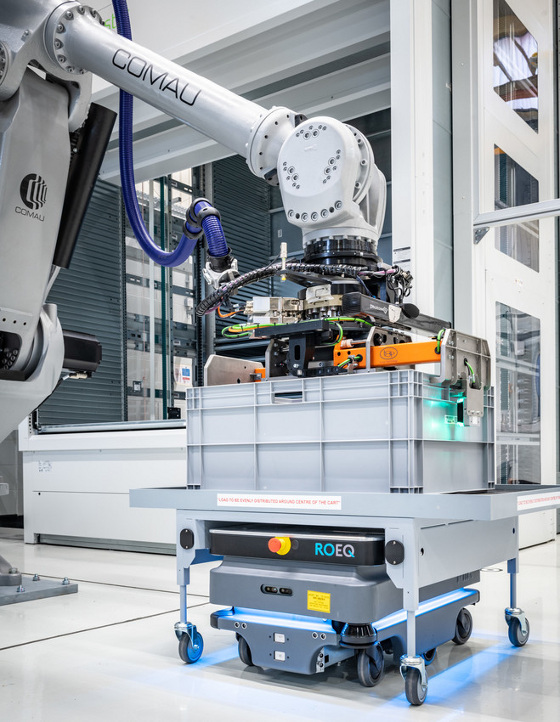
Trackless and intelligent mobile transporters are key to moving things through BAE's Warton factory.
Intelligent machines and off-the-shelf robotic technology from the automotive industry have been modified to operate at the precise tolerances required for military aircraft, which are less than a third the width of a human hair on some projects. Operators often focus on more highly skilled and strategic tasks, and production managers oversee operations from a fully digitized virtual office.
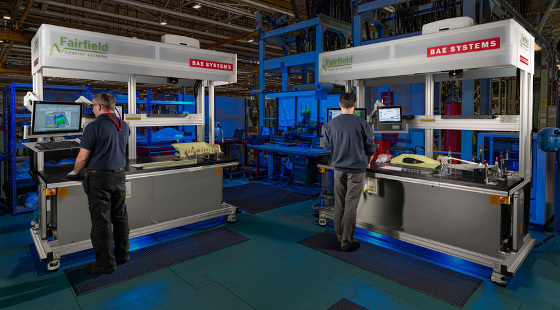
Intelligent workstations at BAE System's Factory of the Future recognize operators and automatically deliver tailored instructions and parts.
Technologies inside the factory are already delivering benefits. The intelligent workstation, developed in collaboration with The University of Sheffield's Advanced Manufacturing Research Center and Fairfield Control Systems, is in use on the Typhoon production line. It uses a system that recognizes operators and automatically delivers tailored instructions using pick-by-light technologies. In addition, additive manufacturing technologies are being used in the production of Typhoon aircraft parts and assemblies.
BMW focuses on augmented reality, 3D printing, and AI
Think augmented reality (AR) is just gaming tech that has yet to really take off? BMW Group doesn't. At its pilot plant in Munich, BMW is using a new augmented reality (AR) application in vehicle concept and prototype engineering, speeding up the process by as much as 12 months from individual vehicle sections to complex production stages. AR goggles allow real geometries (on a vehicle body, for instance) to be overlaid with true-to-scale holographic 3D models, so a range of concept variants and assembly processes for future series vehicles can be assessed flexibly and cost efficiently.
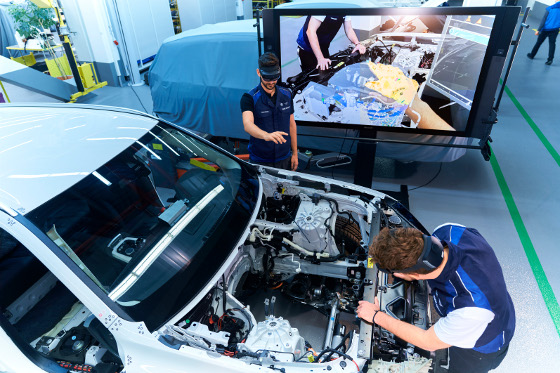
Product developers at BMW use AR technology.
"The AR goggles and CAD data allow us to find out much more quickly whether the production worker will be able to fit the component properly later on in series production," said Michael Schneider, head of Complete Vehicle at BMW's Pilot Plant. "That way, we need far fewer test setups." Using AR also saves time and money when the company integrates new vehicles into production.
Vehicles and their components are visualized on a platform linked to the BMW Group's product data management system. CAD files of components are drag-and-dropped from the web-based database to the AR goggles, which the specialists can then use to reproduce the data in 3D and their original size in a realistic environment. The AR application is controlled by hand, allowing direct interaction with virtual components. (A site called All Motors TV has uploaded a video of AR use in BMW's Munich plant. You can view it here.)
With the AR application, a simple hand movement is enough to modify not only the size but also the position and angle of components. In addition, cross-sections can be created to provide a view of the vehicle's inner structures. Another advantage is collaborative working. People at different locations around the world can now employ multi-user mode to team up and review designs and concepts together and identify any errors.
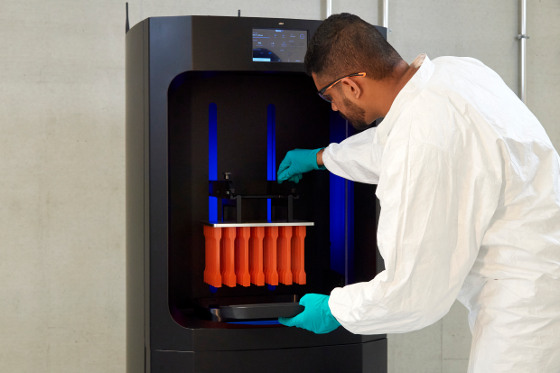
BMW Group recently opened a $17-million Additive Manufacturing Campus just outside of Munich.
At a satellite Pilot Plant just outside of Munich in Oberschleissheim, BMW has just opened its new Additive Manufacturing Campus. It brings together production of prototype and series parts under one roof, along with research into new 3D-printing technologies. Associates also train for the global rollout of tool-less production here.
Last year, the BMW Group produced about 300,000 parts by additive manufacturing. The Additive Manufacturing Campus currently employs up to 80 associates and operates about 50 industrial systems that work with metals and plastics. Another 50 systems are in operation at production sites around the world.
Access to the latest technologies is gained through long-standing partnerships with leading manufacturers and universities, and by successfully scouting for industry newcomers. Back in 2016, BMW i Ventures (the venture capital arm of the BMW Group) invested in the Silicon Valley-based company Carbon, whose DLS (Digital Light Synthesis) technology achieved a breakthrough in planar processes, which uses a planar light projector to enable super-fast component production.
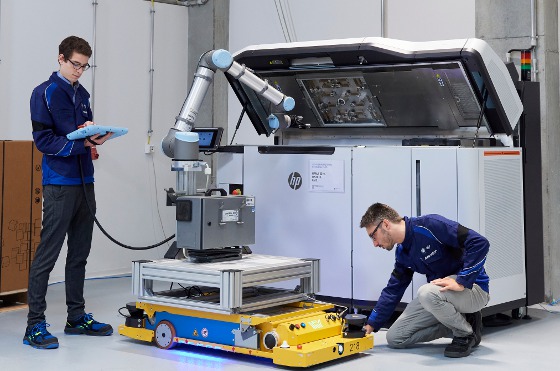
The BMW Additive Manufacturing Campus is incorporating automated delivery vehicles and cobot machine tending technology into their 3D-printing processes.
Further investments were made in 2017, when the BMW Group became involved with Desktop Metal, a start-up specializing in additive manufacturing of metal components and developing innovative, highly productive manufacturing procedures. They also invested in the U.S. start-up Xometry, a world-leading platform for on-demand manufacturing. With its extensive network of manufacturing companies specializing in fields such as 3D printing and metal fabrication, Xometry provides fast access to components.
The latest investment was in the German generative-engineering start-up ELISE, which allows engineers to produce component DNA containing all the technical requirements for the part, from load requirements and manufacturing restrictions to costs and potential optimization parameters.
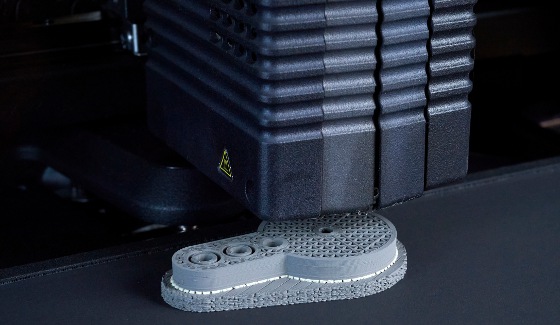
BMW is working on parts made in platics and metals using 3D printing.
One main focus of the Additive Manufacturing Campus is on automating process chains that have previously required large amounts of manual work, which will make 3D printing more economical and viable for use on an industrial scale over the long term.
The BMW Group first started the additive manufacturing of prototype parts back in 1991 for concept vehicles. By 2010, plastic- and metal-based processes were being rolled out, initially in smaller series, to produce items such as the additively manufactured water pump wheel in the DTM race cars. Further series production applications followed from 2012 on, with a range of components for the Rolls-Royce Phantom, BMW i8 Roadster (2017), and MINI John Cooper Works GP (2020), which contains no less than four 3D-printed components as standard.
BMW is also using a growing number of artificial intelligence (AI) applications in production. In one example, the technology relieves workers of monotonous tasks such as checking whether the warning triangle is placed in the right spot in the trunk. This task is now performed by a camera and self-learning software that compares the camera's live images with hundreds of stored images in milliseconds and can detect any deviations from the standard.
They are also sharing selected AI algorithms on an open-source platform (github.com/BMW-InnovationLab). The algorithms are part of various AI applications, mostly automated image recognition and image tagging. Making these publicly available allows software developers all over the world to view, change, use, and improve the source code.
"With the algorithms we are now publishing, the BMW Group has significantly reduced the development time for neural networks for autonomous transport systems and robots," said Dirk Dreher, head of Logistics Planning at BMW. Neural networks independently compare live images in production and logistics with image databases to detect any deviations from the target state.
The open-source approach benefits both interested software developers and the BMW Group. Any flaws in the algorithms can be identified quickly. BMW checks all incoming user suggestions before they are put into productive use or are shared. The main model (the actual AI application being developed with these algorithms) always remains protected by BMW.
Bonus fun video: Eurofighter Typhoon-- "The easiest plane I've ever flown' by Nat Makepeace"
Sources: BAE Systems, BMW Group
Published September 2020
Rate this article
View our terms of use and privacy policy
